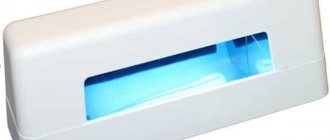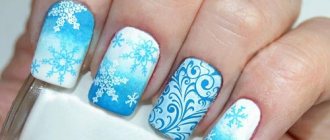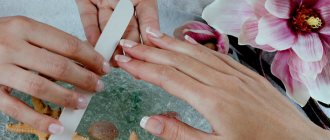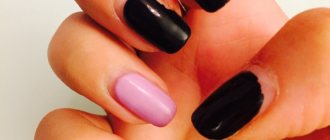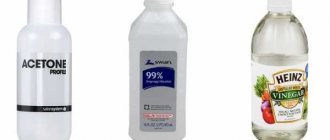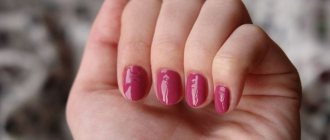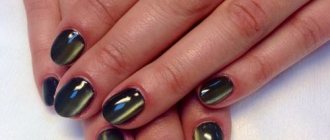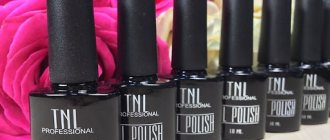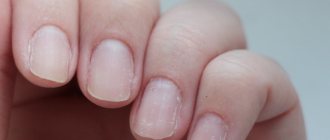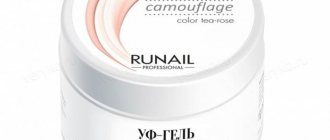A big plus of the coating is its durability (that’s why most girls choose it). It lasts longer than traditional varnish, which is made from nitrocellulose resin. Depending on the growth rate and care, gel polish lasts on average 2-3 weeks, sometimes a month. If you paint it normally, it will start to come off within a few days or even a couple of hours after application.
Gel polish is not harmful to health if the manufacturer refuses to use chemicals
The most dangerously toxic trio are dibutyl phthalate (DBP), toluene, and formaldehyde.
- Dibutyl phthalate is absorbed through the nail bed when manicures are performed by trimming or pushing back the cuticles. This substance is a toxin that causes disorders of the reproductive system.
- Toluene is a solvent and volatile organic compound used in paints and varnishes. It can cause kidney failure, damage to the liver, bile ducts, and muscles (rhabdomyolysis).
- Formaldehyde is a neurotoxin, a poisonous, caustic allergic substance.
In an effort to avoid phthalates, gel polish manufacturers are looking for alternatives. One of them, for example, is triphenyl phosphate (TPHP), a chemical used in the production of plastics to increase their elasticity. However, research shows that triphenyl phosphate can cause endocrine disruption (by interfering with hormonal processes), interfere with metabolism, carbohydrates/glucose, lipids, as well as DNA repair processes, even in low concentrations interfere with normal metabolism and the life cycle of cells.
Duke University (North Carolina) and the environmental organization Environmental Working Group (EWG) have found evidence of the harm of gel nail polish. If the composition contains triphenyl phosphate, it enters the body.
Do not miss
- Do not miss
Manicure without gel polish: 16 cool products (from varnishes to batters)
Another chemical is the harmful waxy antioxidant butylated hydroxyanisole (BHA). There is an assumption that this substance may have a negative effect on the endocrine system. It is used in the production of food packaging, medicines, and cosmetics. It causes tumors in rodents and may even contribute to the development of esophageal cancer in humans if found in foods as a dietary supplement.
Toxic substances are not always listed on the label. In the USA, for example, the components of nail cosmetics do not need to be officially approved and are not required to be indicated. Even if the ingredients are listed on the label, there is no guarantee that all of them are listed.
Pregnancy is not a contraindication for such a manicure. A pregnant woman can wear the covering for up to 3 weeks, but you need to check the safety and technology even more carefully - during this period the body is especially vulnerable.
What does gel polish consist of?
There are hundreds of brands offering nail coatings on the shelves of online and offline stores. In most cases, the composition of these products is identical and includes the same components.
The most common ingredients in gel polish include:
- Monomers . Hidden on the label under the combinations of Hydroxypropyl Acrylate and Hydroxyethyl Methacrylate. Monomers are used to harden the coating when exposed to ultraviolet rays;
- Photoinitiator - Hydroxycyclohexyl phenyl ketone. Absorbs ultraviolet rays and starts the polymerization process. Depending on the manufacturer, the amount of photoinitiator varies, which affects the speed of solidification;
- Pigment is a substance that provides a color coating. The composition is marked with an abbreviation, for example CI 8965;
- Solvents . Used to facilitate polymerization that occurs when entering into a chemical bond with monomers;
- Fragrances . To give the product an unobtrusive aroma of fruits or flowers.
The listed components are the basis of the gel polish, which allows it to create a dense coating on the nails with an increased wear time. In addition to the basic components, the composition also contains auxiliary ones - they are the ones that pose a health hazard.
What components of gel polishes and other coatings should be avoided:
- Formaldehyde, Formaldehyde. The most dangerous component that has been discussed from the first day of its addition to the varnish. Formaldehyde is a preservative that promotes long-term storage of the product and prevents the growth of bacteria. The component is allowed for use in nail polishes, but it is prohibited for contact with skin . Formaldehyde often causes allergies to gel polish coating. Manufacturers often hide the presence of formaldehyde in the composition and use non-standard names on the label - Aldehyd mravenc, Bfv, Methanal. Despite the danger, formaldehyde is actively used by manufacturers. Only in the USA a restriction has been introduced allowing the use of no more than 11% of it in the composition;
- Formaldehyde resin. May lead to skin inflammation and dermatitis.
- Toluene, Toluene is a substance from the group of solvents. Also referred to on the label as methylbenzene, methylbenzene, methane. Toluene is a toxic component, the vapors of which in high concentrations cause disorientation. Naturally, varnishes use a minimal amount of the substance, but even this is enough to cause irritation or an allergic reaction. Prohibited for use in all countries within the European Union ;
- Dibutyl Phthalate, DBP - a component that protects the coating from cracking. It allows the gel polish to plasticize. Dibutyl phthalate has a negative effect on women's health, hormonal levels and provokes problems with reproductive function. In Europe, the component is prohibited for use in cosmetics ;
- Methylisothiazolinone is a preservative that increases the shelf life of the product. Even in small quantities, the component disrupts the functioning of the central nervous system and also negatively affects brain function;
- Camphor, Camphor - used to add gloss. It is a relatively safe component, but with prolonged use it causes allergies. Inhalation of camphor provokes headache and nausea;
- Xylene, Xylene , is another component from the group of solvents that often causes allergic reactions. In addition, xylene may cause side effects such as dizziness, nausea and vomiting;
- Triphenyl phosphate is a plasticizer. It tends to be absorbed through the cuticle and accumulate in the body. Affects the hormonal system. Research by American scientists has proven that triphenyl phosphate has a negative effect on the endocrine system;
- Parabens are sulfate preservatives that mimic estrogen production. Studies have shown that exposure to parabens can trigger the development of breast tumors;
- tosylamide . May cause severe allergic reactions, destruction of liver cells;
- Acetone , Acetone - when inhaled, it can cause inflammation and sore throat.
Is it harmful because of the composition: myths and reality
The composition of gel nail polish is not harmful if it contains only the following substances:
- Pigments. They can be made from natural ingredients. But even if their origin is purely chemical, there is no need to be afraid.
- Photoinitiator. This is the component that absorbs light radiation from the lamp. Thanks to it, the coating dries. And it does not have a negative effect on the body.
- Film former. A component that gives the coating hardness, but also maintains elasticity. The film former prevents it from cracking and pulling on growing nails.
- Solvents. This can be ethyl acetate, isopropyl alcohol, butyl acetate and other components that maintain the liquid consistency of the composition.
- Stabilizers. The substances give the gel polish thickness. The group includes trimethylolpropane, the mineral bentonite, and silicon dioxide. They also do not affect health.
But the opinion about the negative impact of coating on nails and the body as a whole is by no means a myth if the gel polish contains:
- Formaldehyde. This is a known preservative, but it is also a toxic component and tends to accumulate. The substance can reduce immunity, cause allergies, and have a bad effect on the respiratory system. The effect does not weaken as long as formaldehyde is on the nails.
- Toluene. This is also a solvent with a pungent odor, resulting from oil refining, and has a cumulative effect. Its negative effect is mainly on the kidneys, liver and muscle fibers. The substance can also damage your nails.
- Dibutyl phthalate. Another toxic solvent that can interfere with the functioning of the endocrine and reproductive systems.
Fortunately, not all gel polishes contain these components. Newly emerging products do without them, which does not prevent them from being bright and remaining on the nails for a long time.
The most harmful products from the gel polish coating system
Acid primer
It is the primer that helps the coating stay on the nails for a long time, but methacrylic acid spoils the nail plate. As an option, use an acid-free primer, but you shouldn’t believe that there really is no acid in its composition - there is, but another and more gentle one.
A couple of tips to minimize primer damage:
- Experiment. If the coating on the nails lasts more than two weeks without a primer, there is no need to further injure the nail;
- When you cannot do without the product, apply it not to the entire nail, but only to the tip - this will allow the coating to adhere to the stress zone and increase the wear time.
Primers should be used with extreme caution as they provide a fantastic adhesion between the coating and the nail.
It seems to the craftsmen that they bought a quality product, although in fact, an unscrupulous manufacturer added more acid to it. This product cannot be used on an ongoing basis.
Products with a dispersion layer
The sticky layer is the residual stickiness after polymerization of the coating in gel polish. It is the dispersion layer that causes intoxication and allergies, so the skin must be protected, and the work of the master must be careful and fast. After polymerization, the layer is removed with a special means.
Gel polish removers
The main component of coating removers is acetone, which dries out the skin and destroys the structure of the nail.
Acetone vapors irritate the mucous membranes and, with constant inhalation, cause problems in the central nervous system. Because of such a destructive effect, nail artists refuse to soak the coating in favor of cutting it off with a milling cutter.
Lung diseases among manicurists and other occupational diseases, prevention
What harm do polishes and gel polishes cause?
- The first and most common disease is the appearance of allergies. Clients experience irritation and inflammation of the nail bed as well as the skin around the nail. Masters face sneezing, lacrimation and allergic rhinitis;
- With frequent use of toxic coating products, the nail plate turns yellow, thins and becomes brittle. This is most often caused by using an acidic primer on an ongoing basis;
- The consequences are greatest among manicurists. Constant inhalation of vapors provokes the development of allergies and lung diseases;
- Studies have shown that the constant use of nail polishes with a toxic composition affects all organs of the human body, causes kidney failure and even provokes the development of cancer.
How to reduce harmful effects?
The use of high-quality materials guarantees minimal harm. To avoid any negative consequences of manicure, you should follow certain recommendations:
- it is necessary to strictly adhere to the coating technology, without deviating from the existing rules of the procedure;
- pause after three or four applications of the cosmetic product. During the break, it is advisable to undergo a course of therapeutic coatings and paraffin therapy . If your nails become very peeling, you can carry out procedures with fruit acids. Homemade baths and hand masks will consolidate the results;
- Do not manicure on sick or peeling nails. This is especially true for plates affected by fungus. As we have already written, they need to be completely cured before the procedure ;
- if the skin around the nail is too sensitive or cracked, it is prohibited to use decorative coatings until the damaged areas are restored;
- It is necessary to regularly rub medicinal oils into the cuticle area.
How to choose a safe gel polish
You can determine the safety and quality of gel polish at first glance at the composition, but for this you will have to:
- Go to the official website of the manufacturer;
- Find information about the composition;
- Make sure that the composition contains hydroxyethyl methacrylate. The component is sometimes replaced by the abbreviation HEMA. It allows for good adhesion of the coating to the nail, while ensuring easy removal;
- Also look for the Free mark on the label - it indicates that the varnish does not contain some toxic substances.
If one of these words is found in the composition, you have a professional and safe product. Please note that the presence of these substances does not guarantee that the varnish will wear well and will not crack or chip. Finding the ideal product will only be possible through trial and error.
What do cosmetics consist of and potentially dangerous components?
Security categories Free
Manufacturers of nail polishes indicate on the label the safety category “Free” plus a number from 3 to 12. Such polishes are “free” from a number of toxic chemicals that can cause serious illnesses.
3-Free
3-Free varnishes do not contain formaldehyde, toluene or plasticizers.
There are several varnishes of the 3-free category on the Russian market:
- Divage;
- Orly;
- Patrisa Nail;
- Rimmel;
- Maybelline.
5-Free
In addition to formaldehyde, toluene and plasticizers, 5-Free products also do not use formaldehyde resin or camphor.
Brands designated 5-Free:
- Aurelia;
- Chanel;
- Zoya;
- Inglot.
7-Free
7-Free varnishes are free of xylene, formaldehyde and its resins, camphor, triphenyl phosphate, toluene and dibutyl phtholate.
Lucky 7-free:
- ANNY;
- CND Shellac;
- Jessica;
- LVX.
8-Free
8-Free does not contain the 7 components listed above and does not contain parabens.
There are not many products on the Russian market without 8 hazardous substances:
- By Terry;
- Smith & Cult;
- Tenoverten.
10-Free
10-Free polishes are considered vegan. They do not contain all of the above harmful substances, as well as components of animal origin - guanine, keratin and carmine, and are not tested on animals.
No toxic substances are used in production. Vegan polishes:
- ZAO;
- Butter LONDON;
- Color Club.
You can also find 11, 12 and even 13-free on sale, but this is more of a marketing ploy. Manufacturers do exclude some common ingredients, such as gluten, which is inherently safe. Gluten can cause negative reactions only in a narrow part of the population - those who are lactose intolerant.
Safe gel polishes
There are relatively safe products not only in the luxury segment, but also in the economy segment. Let's figure out which brands to pay attention to first.
CND
The American brand has earned the attention of craftsmen thanks to the release of a product called Shellac.
- The properties of the product are no different from gel polish, but it allows you not to use a primer - this makes it even safer in comparison with conventional gel coating.
- Shellac from CND complies with the 7-Free standard.
- The brand has a wide color palette and also has an MSDS safety data sheet, confirming compliance with international quality standards.
- Shellac contains no formaldehyde or toluene.
The shellac coating system is safer than the average gel polish. But, at the same time, if you set a goal, you can choose a gel polish that is safer than shellac. For example, from 8- or 10-Free funds.
All about shellac - properties and comparison with other coatings, how to do a manicure
Opi
Another American brand that has become a favorite among nail artists. Opi is a leader in the nail services industry and cares about the quality of its products. The palette here is no smaller than that of CND, but the coating ends up being somewhat thinner. The composition excludes components harmful to clients and artists, and also contains amino acids that are beneficial for nails.
Kodi
The American brand became famous thanks to its rubber formula, which provides a plastic, durable coating. Only safe components are used for production, and the base is a rubber polymer of natural origin. Natural rubber is resistant to alcohol, water and acetone.
Bluesky
The budget brand offers more than a hundred shades and is also famous for its safe composition. Apart from the Pigments and components necessary for polymerization, nothing else is indicated in the composition. Many professionals who are satisfied with the price-quality ratio work with the manufacturer’s gel polishes.
However, there have been cases where customers have reported an allergic reaction to Bluesky. There is no documentary evidence of its allergenicity, so the gel polish continues to be listed as safe.
Beautix
Beautix is a professional brand of high quality manicure products. The safest components are used for production, which minimize all risks associated with applying gel polish. The main advantage of the company’s gel polishes is that they are practically odorless.
The palette includes more than 200 shades.
CNI
Another professional brand with a lot of positive reviews. Many masters switched to CNI after CND and were satisfied, and this speaks of the European quality of gel polishes. The manufacturer does not classify its products as “free”.
Nano Professional
The gel polishes of this company are gaining more and more popularity every year. This is because in the Nano Professional laboratory daily experiments are carried out to improve the composition and increase its safety. There are no dangerous components in the composition, and animal products are also excluded.
BANDI
In Russia, the brand is not so widespread, while in Korea the company occupies 60% of the market. The thing is that the manufacturer has developed an innovative product for Korea - 7-free gel polish. You won't find in the composition:
- Toluene;
- Formaldehyde and its derivatives;
- Camphor;
- Dibutyl phthalate;
- Tosilami;
- Xylene.
Naturally, as expected for environmentally friendly companies, BANDI gel polishes are not tested on animals.
Nailor
Each tone is given the name of a great artist - there is Repin, Serebryakova and Aivazovsky. Due to the fact that Nailor gel polishes have not yet become as widespread as CND or, say, Beautix, there is no information about their quality in terms of wear yet. There is no fault with the composition - it belongs to the 9-free category.
The following are not used in production:
- Formaldehyde and its resins;
- Toluene;
- Xylene;
- Dibutyl phthalate;
- Camphor;
- Tosilamide;
- Triphenylphosphate;
- Parabens.
The composition of the varnish complies with European Union quality standards.
The technology of nail makeup with soft varnishes is a more environmentally friendly option for nail design:
What is nail makeup and how is it done?
Option
Almost all Option products are hypoallergenic, with the exception of some gels. Organic pigments are used in production, and all hazardous components are excluded. According to the information on the packaging of Organic gel polishes, they consist of:
- Urethane oligomer;
- Photoinitiator;
- Hydroxyethyl methacrylate;
- Pigment.
The “Options” palette is quite modest - a little more than 50 shades, including basic, basic colors. The reason for the limited choice is the difficulty of working with organic pigments - they are capricious and do not always lend themselves to experimentation. The brand's products have eco-certificates confirming their safety and environmental friendliness. We spoke separately about our use of the Organic line of the Option brand.
Lianail
The Russian brand Lianail offers gel polishes of the 9-Free category, free of formaldehyde and its derivatives, xylene, camphor, dibutyl phthalate, toluene, and parabens. The latest development of the brand - the Factor collection, which, in addition to its safe composition, has excellent strength and amazing self-leveling - is suitable even for beginners.
The range of shades is huge - from barely noticeable nudes to rich reds, blues, yellows. In addition, there are bases, tops, design products, and cuticle oils.
Experts' opinions
Constantly applying a coating to the nail plate can be dangerous. According to cosmetologists, when using it, the risk of complete onycholysis—separation of the nail from the bed—increases sharply. You should definitely give your nails a “vacation” and at least once a year not do a “heavy” manicure for some time.
A serious factor is the tools used to do a manicure. Experts believe that almost any nail service can be considered a “high-risk area” in terms of fungal and even more serious infections. When contacting a manicurist, you need to be firmly convinced that the rules of hygiene and sterilization are observed at his workplace.
How to protect yourself from allergies and get rid of symptoms
Not the most natural composition, the presence of harmful and allergenic components - this causes itching and inflammation on the client’s hands. But if you follow simple tips, you can reduce the risk of developing allergies to a minimum and get rid of the symptoms of the disease that have already appeared.
- If an allergy has already manifested itself, do not cover your nails with gel polish or other means until complete recovery;
- Choose varnishes from the “Free” category. For example, 3-Free does not contain formaldehyde, which most often causes an allergic reaction;
- Avoid accompanying medications as much as possible, especially if they are not urgently needed. For example, if the coating adheres well even without a primer, you should not further injure the nail plate and body with it.
Allergy to manicure: how to determine the cause, remove symptoms and how to replace gel polish
How long can you wear without harm?
In any case, there is some harm from gel polish, but much depends on the duration of contact between the nail plate and the coating. You can usually wear a manicure for no longer than two weeks. Under the influence of daylight or natural ultraviolet rays, the coating gradually becomes more dense.
It will be more difficult to remove when visiting the salon. The longer gel polish is left on the nails, the more damage it causes and the greater the risk of injury when removed.
Some tips for craftsmen
Masters are several times more susceptible to side effects from using toxic products than their clients. To make work safe, and also not to encounter the development of diseases, it is recommended to follow several tips:
- Use only high-quality products - this will affect the quality of your manicure and protect you from allergies, headaches and other side effects;
- Wear gloves. Yes, it will be uncomfortable at first, but by protecting your hands, you will save your skin from contact with harmful substances of the composition;
- Use a mask to reduce the amount of fumes and dust you inhale.
Personal protective equipment for a manicurist - all types of harmful effects in the salon and how to protect yourself
